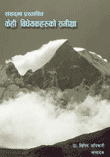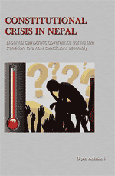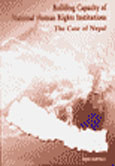The Setting – Dr. Sriram Bhagut Mathe
I have just finished reading Dr Bipin Adhikari’s Nepal Constituent Assembly Impasse: Comments on a Failed Process. This is a very timely and scholarly work. I am not aware of any governmental or non-governmental organization in Nepal undertaking this type of publication, which attempts to explain in some detail, with relevant references, why the Constituent Assembly failed in its primary mission in promulgating a new, better and inclusive constitution.
Comments on a Failed Process. This is a very timely and scholarly work. I am not aware of any governmental or non-governmental organization in Nepal undertaking this type of publication, which attempts to explain in some detail, with relevant references, why the Constituent Assembly failed in its primary mission in promulgating a new, better and inclusive constitution.
Apart from this major focus, this book also explores the way forward to break the current impasse so that the country can succeed in completing the onerous task of writing a new constitution, based on sound democratic precepts, including rights and responsibilities, checks and balances, separation of powers and the rule of law. Such a constitution must also ensure the inalienable rights of the individuals as well as guarantee the integrity of the nation and assure the peaceful and progressive economic development of the country.
At the outset, I must note here that this book succeeds in highlighting the reasons behind the failure of the Constituent Assembly and how the country has been held hostage by the political parties and the political leaders, who have put their and their parties’, and later on in the constitution-making process, their ethnic and divisive interests first, when they should have put the country’s national interests central in all their dealings and decisions. In most of the cases, they were acting under pressure and at the behest of so called “external”/”sinister” forces. As a result, the political parties have miserably failed in addressing the legitimate aspirations of the Nepalese population for a peaceful, progressive and dynamic Nepal.
As things stand now, the country is facing a dire constitutional crisis because the Interim Constitution 2007 did not envisage this eventuality. The road ahead is fraught with danger. In this book, Dr Adhikari, who is a leading constitutional expert, has tried to explain why the Constituent Assembly could not deliver a new constitution. This is not the only work of the author on constitution building. There are few others as well. In April 2009, Adhikari produced a model constitution for Nepal that could serve as a basis for discussion at the Constituent Assembly. He also published an additional work in 2010 based on an international constitutional conference held on the thematic reports as produced by the Constituent Assembly at that point of time. The idea was to provide international perspective to the Assembly members on local issues. The book Nepal: Design Options for the New Constitution was a precious reference document especially to those members of the Assembly, who were grappling with contentious constitutional issues at the Assembly. Two months before the dissolution of the Assembly, in March 2012, Adhikari produced another new work called The Status of Constitution Building in Nepal which tried to summarise the progress during the forty-six month of operation of the Assembly. It also dealt with the contentious issues that remained unresolved despite several efforts. While the previous books intended to help the Assembly and the political class of Nepal to work on a constitution that could be acceptable to most of the Nepalese people, this current work on deals in great depth on the causes and effects of Constituent Assembly failure.
Like any other constitution making organ, the Constituent Assembly of Nepal was an assembly of people’s representatives elected by the people through “first past the post (FPTP)”and “proportional” election system, and members nominated by the decision of the Council of Ministers. As per the provision of the Interim Constitution, there were 601 members in the Constituent Assembly. The main objective of this inclusive body was to draft a new constitution for Nepal and adopt it through due process. The Interim Constitution itself provided applicable adoptive procedures.
To make the constitution making process systematic and regular, the Constituent Assembly Rules 2008 created provisions to form various working committees under the Assembly. As per provision of the Rules, one Constitutional Committee, ten Thematic Committees and three Procedural Committees were formed within the Constituent Assembly. The Rules assigned the thematic committees to prepare the preliminary constitutional drafts under the given terms of reference and tasked the Constitutional Committee to formulate an integrated draft of the constitution based on the preliminary thematic drafts and reports. Article 70 of the Interim Constitution laid down the provisions clearly defining the plenary proceedings to adopt the new Constitution.
Unfortunately, the Constituent Assembly could not promulgate the new constitution as desired. Even though the process adopted for this purpose was correct, the leadership of the main parties got sidetracked from their primary constituent responsibility by executive issues and unnecessary “power play” resulting in frequent change of government. As such, the political leaders of the major parties were too involved in political machinations, when they should have been totally focused on dealing with the many constitutional issues. As a result, the Assembly failed to finalise the new constitution by the 2010 deadline, as originally provided by the Constitution. It, unashamedly, voted to extend its own term four times in the one and half years beyond the original deadline.
The entire tenure of the Constituent Assembly was marked by political turmoil with four unstable governments in four years. With every change of government, the people’s aspirations took a beating as the interests of the political parties took precedence over national interests. Even after 4 extensions of the “jumbo” Assembly, which many critical thinkers, considered too big, unnecessary and economically unaffordable for a small country like Nepal, efforts were made to extend it for another three months again. But the Supreme Court ruled on 24th May 2012 that a further extension was unconstitutional and a fresh mandate was necessary.
Nepal plunged into a new political and constitutional crisis after Prime Minister Dr Baburam Bhattarai declared dissolution of the house on May 27, without adopting any constitution. He also declared himself head of a caretaker government and announced elections for November 22, 2012. This declaration was not made in the Constituent Assembly but through televised address to the nation. The demise of the Assembly without any formal session to take decision about its exit strategy was one more indication of how national interests were pushed to the background by the government of the day. The demise of the Assembly was not a failure of the political process but, definitely, a failure of political parties and their leadership, with the principal onus on the big parties, who failed to agree on a new constitution after four years of wrangling and repeated extensions of the Assembly’s term.
What has happened is clearly a lesson for all of us on how not to write a constitution. The book, apart from delving in depth about the failure of the Assembly and the events leading to it, also recommends a possible way forward by forming a national government and giving continuity to the remaining tasks on constitution building. There is no other way out than holding elections to seek a fresh mandate from the people, who have become very disillusioned over the past few years. However, there are enormous challenges in holding the elections without consensual political decisions on the outstanding contentious constitutional issues.
The only way forward at this critical political juncture is for the political leadership, especially of the major parties, to exercise statesmanship by focusing on national interests and how these national interests can be enshrined in the new constitution. Democracy, and the protection of the inalienable rights of the individuals, national reconciliation and national sovereignty must be the underpinning precepts on which the new constitution must be founded. The new constitution must ensure peace and economic progress, and inclusive participation especially from the marginalized groups, preserving the cultural diversity, as well as ensuring national integrity. If a new peaceful and progressive Nepal is to be created, the political parties and their leaders have to look beyond their own and their parties’ interests and focus on long-term national interests. They have the unique opportunity of either becoming “statesmen”, who will be remembered by posterity for making genuine contribution to nation-building at a very critical and sensitive period of our county’s history, or “petty and selfish” politicians, who could not see beyond their own selfish, ethnic and party’s interests and who will be consigned to the dustbin of history. Only time will tell of the choices that these leaders will make. Hopefully, “statesmen” will emerge to guide the process of completing the task of writing a new constitution and give relief and renewed hope to the people.
In course of our country’s tumultuous history, especially in the post-1950/51era, many opportunities for laying the groundwork for long-term prosperity of Nepal have been lost. In the various elections, people of Nepal have exercised their franchise and made their preferences clear, giving opportunities to the various parties to lead the country. Our people are generally tolerant and forgiving. The political parties and the leaders have time and again tested this tolerance and have betrayed time and again the trust placed on them in creating a just and stable society, that gives equal opportunities to all, without any bias against caste, ethnicity, gender, religion, culture, creed, ethos, etc. The people generally have become very disenchanted with the political parties and their leaders. They have literally run out patience. The demise of the Constituent Assembly and the way it happened has literally dashed the hopes of the people. In this very uncertain political situation, the political parties and leaders have one more opportunity to exercise their statesmanship in seeking national reconciliation and coming up with a constitution we all can be proud of. Ensuring basic rights, adequate checks and balances, equitable distribution and separation of powers amongst the executive, legislative and judicial entities are central to a good constitution.
Having read Dr. Adhikari’s book with great interest, I have no reason to disagree with Dr Adhikari’s prescriptions for managing the current crisis. While the respect for fundamental democratic principles is essential to guarantee the aspiration of Nepal’s citizens for peace, stability, and prosperity, it is also a fundamental truth that no constitution should be promulgated compromising the core national interests of this country. There is universal agreement that the new constitution must enforce our commitment to inclusive, multi-cultural and secular values along with the restructuring of Nepal in such a way that every person in the country is empowered to take part in nation building. While celebrating our cultural differences, we must be cognizant of our commonality, our bonds of unity, common destiny and commitment for an independent, indivisible and prosperous country.
As Dr Adhikari has put it, what Nepal needs desperately at present is adherence to the principle of national reconciliation. This principle is based on the understanding that both democracy and nationalism are necessary and complementary. Democracy should not come at the cost of nationalism, nor nationalism at the cost of democracy. Independence of the country and sovereignty of the people must not be compromised, no matter the enormity of the challenge. This requires development of a genuine trust between all sectors of our society – modern and traditional. Only when the country is internally strong can it chart its own future. The problems that the country has been facing, constitutional or political, exist because the policy of national reconciliation, as well as national sovereignty, is consistently ignored giving rise to divisive forces with myopic vision. The Assembly failed, despite several efforts, because it was not intended to be successful by those who planned it. It failed because, in the eyes of common people, it was neither able to ensure drafting of a democratic constitution nor was it able to safeguard vital national interests and considerations of Nepal. The entire period of instability in Nepal over the last ten years or so has been used to deconstruct the country internally and promote the interests of the external forces in Nepal. Let us hope and pray that history will not be repeated in the coming days.
As I come to the end of this foreword, I can only remember the visionary statesmanship of late B P Koirala, who advocated democracy and promoted national reconciliation to ensure national sovereignty and national integrity. His visionary teachings and values are timeless and even more relevant today as divisive and regressive forces are bent on breaking up this country’s independence, its rich national identity, culture and uniqueness by stoking the fires along ethnic fault-lines. If our current crop of political leaders, most of whom pay lip-service to BP Koirala’s vision and statesmanship, could understand his core teachings, this county’s future could be assured. It is most unfortunate that Koirala passed away when he did. If he had lived longer, maybe the country would not have been in this present predicament. The whole country is anxiously looking for visionary statesmen like B P Koirala to guide the country through the current political morass.
In conclusion, I would like to recommend this book to all those who love Nepal and wish Nepal to be a strong and prosperous country. I personally found the book very engrossing and I was enlightened by both the contents and the style. It is indeed a scholarly reference book, that sheds light on the creation and demise of the Constituent Assembly as well as thoughts on the way forward. I am confident that anyone reading this book will find it very enlightening. I have known the author and have worked with him for almost a decade and half. I have always found him to be an independent constitutional scholar, with clear thoughts and arguments in the context of nation building. I know for a fact that the author is a democrat and a nationalist as I am and as many of the Nepalese are.
Sriram Bhagut Mathe, PhD
August 2012
Chairperson of Nepal Education Foundation – Consortium of Colleges Nepal
(NEF-CCN),
Chairperson of Asian Institute of Technology and Management (AITM),
Former Dean of the Institute of Engineering, Tribhuvan University,
Founder Chairpeson, Xavier Academy,
First Campus Chief (Principal), St Xavier’s College





